Centauri Dreams
Imagining and Planning Interstellar Exploration
Exoplanet Targets in Nearby Space
I’m a coffee fanatic. Not only do I drink a lot of the stuff, but I roast my own beans and love fiddling with roasting times and fan speeds, trying to hit exactly the right note. And with a just-brewed carafe of Burundi by my side this morning, it’s natural enough that I would be drawn to an exoplanet tool called ESPRESSO. Echelle SPectrograph or Rocky Exoplanet and Stable Spectroscopic Observations is the next generation spectrograph for the European Southern Observatory’s Very Large Telescope, which has already played such a huge role in finding distant worlds.
Using the HARPS spectrograph, the VLT already holds the record for most exoplanet discoveries from equipment on the ground. Upgraded with ESPRESSO, the VLT should be primed for even more fine-tuned radial velocity measurements. HARPS was designed to get us down to about the 1 m/s level, although its effective precision is considerably tighter. But we’re still not in range of Earth-like planets in the habitable zone. The Earth creates a radial velocity variation of 9 cm/s on the Sun, about three times smaller than HARPS can work with. ESPRESSO makes up the difference, taking us down to a few cm/s if all goes well, making detection of habitable planets in Earth-like orbits feasible from the ground.
Installation at the VLT is currently scheduled for 2016. As we ponder near-term developments like this, it’s intriguing how much is happening to push our knowledge of smaller exoplanets forward right here on Earth. The Next-Generation Transit Survey (NGTS), like ESPRESSO, follows a highly successful predecessor, in this case the Super-WASP project that went after exoplanets on the cheap. That’s ‘cheap’ as in camera lenses bought on eBay that have found 65 exoplanets.
Although Super-WASP (Wide Angle Search for Planets) demonstrated how successful searches could be managed from the ground, the Kepler ‘long stare’ into the Lyra/Cygnus star field examined planets whose transits are in many cases at the limit (or beyond it) of ground-based follow-up observations. NGTS goes after ‘hot Neptunes’ and ‘super-Earths’ from its site at Cerro Paranal at the European Southern Observatory in Chile, looking for transits around bright, nearby stars. These are transits that would allow follow-up observations by radial velocity methods, revealing not only the radius but also the mass and density of these worlds.
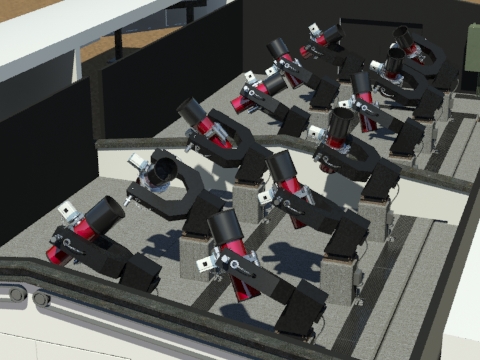
Image: Artist’s impression of the completed NGTS, a robotic facility to be sited at ESO-Paranal. Credit: Next-Generation Transit Survey.
Quoted in this feature in Astrobiology Magazine, Warwick University’s Peter Wheatley, co-principal investigator for NGTS, says the idea is to gather “… the first statistical sample of measured densities for small planets.” He adds: “We believe this sample will allow quantitative tests of planet formation, migration and evolutionary models, and will drive the development of future models.” But with space-based equipment like Hubble and the James Webb Space Telescope in the mix, we can also look toward identifying useful targets, smaller planets bright enough for their atmospheres to be studied through ‘transmission spectroscopy,’ where starlight that is absorbed as it passes through the atmosphere is analyzed to flag its components.
From the NGTS site:
The observation of the planet during its transit at many different wavelengths allows us to obtain its transmission spectrum (stellar light passing through the planet atmosphere). The transmission spectrum is measured by identifying the small differences in transit depth as a function of wavelength. This technique usually requires extremely high signal to noise data and has been successfully applied only on a few planets orbiting bright stars, like for example HD189733. However it is a powerful technique measuring the distinct signature of chemical components in the atmosphere of a planet. This technique can be used to search for water on some planets, and even eventually for biomarkers on rocky planets. It has been successfully carried out on GJ1214b, a Neptune type planet, using FORS [FOcal Reducer and low dispersion Spectrograph] observations. However, the discovery of additional bright targets is essential for this technique to be more widely applied to planets in the Neptune size range.
And here’s the GJ1214b work, showing how the transit light curve can be used to tease out atmospheric information:
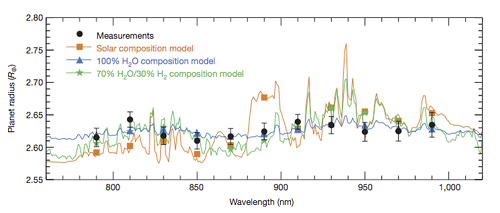
Image: Transmission spectrum of GJ1214b measured by FORS (Bean et al. 2010). Credit: Next-Generation Transit Survey.
The Next-Generation Transit Survey is to be a robotic installation using an array of small telescopes operating in the 600-900 nm band, maximizing their sensitivity to K and early M-class host stars. Finding the brightest exoplanets in the ‘hot Neptune’ and ‘super-Earth’ categories will give us fodder for study by the VLT as well as Hubble and JWST, with all key technologies already demonstrated through a successful prototype. Also aided by NGST data will be the European Space Agency’s CHEOPS (CHaracterising ExOPlanets Satellite), slated for 2017 launch, which will target already identified planets to improve their transit measurements.
Ground- and space-based instruments are intertwined as we push exoplanet studies toward smaller and smaller planets. We already confirm many transits through radial velocity methods with tools like HARPS, but to take the study of exoplanet atmospheres to the next level will require even larger observatories like the planned European Extremely Large Telescope, or the proposed Colossus. In an era of big equipment, it’s heartening to think that relatively inexpensive tools like the NGTS can play so vital a role in finding the targets for these behemoths.

Starship Century, Part Two
Adam Crowl concludes his discussion of the recent Starship Century conference in San Diego. Videos from the session are now becoming available online.
by Adam Crowl
Lunch at the Starship Century Symposium was provided by UCSD, allowing attendees to remain nearby, adding to the discussion and trading of ideas and concerns. Certainly I appreciated the chance to catch up with friends and faces from the other side of the Pacific, as well as meeting new people. Having read people’s novels, books or scientific papers for years, then meeting them on Facebook or email, I felt like I knew some of them already. Meeting authors that I had grown up with like Larry Niven, Joe Haldeman or David Brin was something I was getting used to, as I was more eager to discuss their interstellar ideas than succumb to fan-shock. I finally had my ideas about Larry Niven’s fusion-shield, from his “Known Space” stories, confirmed by the source, but didn’t quite get to talk to David Brin about the Fermi Paradox during the whole event.

The afternoon of the first day was thematically about “New Space” – what we’re doing, as a species, in the near term of a commercial nature. Of course, this was largely from the North American perspective. Patti Grace Smith [video], one of the senior Regulators of “New Space” in Washington DC, spoke about her role in helping commercial space efforts by creating a more operator friendly legal environment. Patti also gave a summary of the key-players in commercial sub-orbital and orbital commercial space efforts, the most prominent being SpaceX, while the most secretive has been Blue Origin, whom Patti has encouraged to be more open.
Image: Patti Grace Smith speaks on commercial space.
Beyond Chemical Propulsion
Once we’re in orbit the only way is Out – into the wider Solar System. Chemical propulsion isn’t up to the task, so Geoffrey Landis [video] made the argument that Nuclear Thermal Rockets (NTRs) will be the “Workhorse of the Solar System”. Geoff’s presentation was based on material presented previously, to more technical audiences, and the technical reports he referenced are also widely available. So he focussed initially on the long history of the NTR in astronautics – dating back to the late 1940s and almost brought to operational readiness by NASA’s nuclear rocket program, before being shelved in the early 1970s. Since then research has focussed on newer materials and newer testing techniques of reactor designs, largely via computer simulation and hot hydrogen gas experiments to simulate the operating environment of engine components. An important point is that NTRs allow transport of humans and their machines in reasonable time-frames all the way to Jupiter. Inside the orbit of Jupiter there exist many sources of the chief NTR propellant – hydrogen – usually in solid form attached to oxygen as water. Conveniently water has many other uses for human beings, thus will be in demand.

Image: Ian Crawford (left) and Geoffrey Landis.
That key point lead neatly into the next presenter’s talk. Chris Lewicki [video] of Planetary Resources gave an intriguing overview of the next steps for one of the first “asteroid mining” companies. Chris had clearly covered the material many times before, showing a polish that only comes with practice. The inner Solar System has abundant energy from the Sun, and convenient chunks of material orbiting in free space in the form of asteroids (and dead comets), but the first task is prospecting and finding the most convenient resources to retrieve from their distant orbits. Thus the Planetary Resources plan of building small satellites with autonomous control, to minimise ground-control costs, and many of them, to achieve savings via mass-production. Interplanetary prospectors that are cheap enough to crash into an asteroid if that’s what the mission requires. Eventually the quest for precious high-value materials in space to return to Earth will also have the side-benefit of producing great volumes of useful in-space materials, such as water. In time the inner Solar System could have a viable network of resource trading, with precious metals being dropped back to Earth via “whiffle-balls” of foamed metal, and storage depots of liquid hydrogen for Landis-style NTRs carrying people to the Moon, Mars and the asteroids.
Panel: The Future of New Space [video]
With those thoughts in mind the day ended with a special presentation and viewing of a small fraction of Arthur C Clarke’s paintings and memorabilia, now at the Geisel Library. Seeing promotional material from 2001: A Space Odyssey“, signed by the actors, and similar items made me mindful of the vast legacy that Clarke’s work had inspired. In the nearly 50 years since he began working with Stanley Kubrick on 2001, we have achieved but a tiny part of what the 1960s imagined possible, a reminder of the difficulty of making dreams real.
Among the Starship Designers
Intense conversations ate up the hours after the scheduled activities, shadowed by my awareness that I was to be the first speaker on Day Two. My sleep was a broken few hours, an hour at a time, looking at the clock, while my subconscious was working on arranging what I would say. Needless to say, I have no idea how the delivery looked, as I covered slide-after-slide of starship concepts – most of which are covered in the anthology [video]. One gratifying aspect was being able to point out several starship designers in the audience – Freeman Dyson nodded approvingly when I discussed his interstellar Orion from 1968, and I discussed Al Jackson’s role in the development of the laser-powered ramjet. As a parting note I mentioned the “Ultimate Starship” – my personal suggestion, based on the late Robert Forward’s idea of a neutrino-rocket, to use electroweak unification physics to convert ram-scooped mass directly into a neutrino-jet. One day I will need to write the paper.
Jim Benford [video] covered the concept of microwave sail-ships, giving a fascinating look into his experimental work in the late 1990s with carbon-sails in vacuum chambers, being made to do amazing things via concentrated beams of microwaves. Jim, like his brother Greg, is a physicist, an alumnus of UCSD, but an applied physicist who has literally written the book on high-power microwave systems, such as the million-watt RADAR regularly used by the world’s armed forces. Thus he is well able to discuss the practicalities of propelling sails to interstellar speeds via beams of microwaves and has written several papers covering the economics of micro-wave starships. An elementary conclusion of the Benfords’ experiment is that a conical sail can very effectively ride a polarised microwave beam and be spun so it is self-stabilising. A less encouraging finding is that the cost of energy will dominate interstellar missions at high-speeds. Before we can reach the stars we will need to create abundant energy supplies.

Image: James Benford (left), Larry Niven and Gregory Benford at the book signing.
Next up was John Cramer [video], a physicist from the University of Washington, well-known to SF fans via his “Alternate View” columns in Analog, as well as several novels. John focussed on the use of wormholes to allow rapid transit to other star systems. Wormholes are simply connections between two points in space-time, compatible with Einstein’s equations of General Relativity as one possible mathematical solution. Outside the wormhole itself, observers would see two “ends” of the one space-time structure. Whether they exist or not is a matter for astronomical observation, as larger wormholes should produce distinctive gravitational lensing patterns that astronomers might be lucky enough to see.
If the connection formed between the two ends of a wormhole is shorter than the distance through regular space-time, then passing through the wormhole allows apparently faster-than-light travel, though nothing ever exceeds lightspeed locally. Thanks to time-dilation – the slowing of time experienced when approaching lightspeed – a time-lag can be developed between the two ends if one end is sent to a distant star. For example, if one end is accelerated to a time-dilation of 7,000 (0.99999999c), then only 75 minutes is required for the travelling end to appear to travel 1 light-year from the stationary end’s point-of-view. John Cramer discussed how this might allow a network of rapid-transit wormholes to be set-up throughout the Galaxy – with the caveat that the network can’t be allowed to form a “Closed Time-like Circuit” else this might destroy the wormholes via amplifying quantum fields.
On Target Stars and Life
Before lunch British astronomer Ian Crawford [video], a fellow member of Project Icarus, discussed what we might find amongst the nearer stars, out to 15 light-years. A planetary system probably exists around every star, something we can say with statistical confidence thanks to the work of the “Kepler” exoplanet detection mission, but discerning every planetary system will require improvements on current techniques. And we almost certainly haven’t found every small star within 15 light-years yet, as the 2013 discovery of a brown-dwarf binary at just 6.5 light-years should remind us. Ian made the forceful point that even with vast telescopes able to image those many new planets and stars, there’s only so much we can learn via telescopes. If we find a planet showing all the signs of life, we will only know more by actually going there – via robotic proxy, in Ian’s opinion.
Once we do go, will we survive? This was the after-lunch opener from Paul Davies [video], who posed the puzzling question of how terrestrial life might interact with truly alien life in another star-system. Could they co-exist, with no biochemical compatibility at all? Could they share common simple biochemicals, but foreign genetic and protein chemistry? Or could the two integrate in ways we haven’t yet imagined? Even more intriguingly, Davies suggested that we might already co-exist with “alien” biochemistries on Earth – organisms might exist in niches that otherwise exclude our kind of biology. A suggested location might be at temperatures higher than what known microbes can tolerate, or in highly alkaline fluids, such as what seeps from the ocean thermal vents. Davies has suggested, in more than one book, that any life on Mars shares a common ecosystem with Earth, due to the trade in meteorites between the planets over the aeons. Mentioning this sharing of life between planets produced an outburst from Robert Zubrin, who is an advocate of interstellar transfer of life throughout the Galaxy. A credit to Davies, his response was more interested curiosity than the reflexive dismissal Zubrin seemed to expect. His answer was that we simply don’t know enough to rule out the possibility and they should discuss it more later.

The Benfords encouraged researchers to present in the audience, with divergent points-of-view. These share a desire to bridge the space between the stars, but differ in details of how and why we’ll go to the stars. The next speaker unified the many voices by sharing his sense of wonder at the Universe, through a living work of art – Jon Lomberg [video] and his Galaxy Garden. Long-time readers of Centauri Dreams will know of Jon Lomberg’s artwork for Carl Sagan’s Cosmos in the 1970s and his Galaxy Garden in Hawaii. Having Jon share it with us, a guided-tour in slides, was inspiring and drew multiple rounds of applause from the audience. As Jon put it we can be Citizens of the Galaxy now.
Image: Artist and Galaxy Gardener Jon Lomberg.
Two discussion panels concluded the Symposium. The first, chaired by Jill Tarter, of the SETI Institute, featured Ian Crawford, Robert Zubrin, Geoffrey Landis, Paul Davies and myself. Our theme was “Getting to the Target Stars” but with Jill as the chair we wandered into the search for others who might have made the same journey [video]. Jill gave a brief summary of false-positive detections of extraterrestrial technology, which have proven to have natural explanations.

Image: Jill Tarter gives the lowdown on false-positives in SETI.
The sole exception, the distinctive spectroscopic signature of tritium, has no natural explanation if it is ever detected. With that in mind each of the panelists made suggestions about how we might detect aliens – Robert Zubrin mentioned the distinctive radio output of a starship deploying a magnetic sail, while I suggested the Solar System be searched for dead starships, since not everyone succeeds in their long voyages. A final task was to sum up how we thought humanity would go to the stars. A common feeling seemed to be via robotic proxies, or nanobots. In my opinion, by the time we are ready, the distinction between “human” and “robotic” might be meaningless or arbitrary – thus my quip “Nanobots are people too.”
The final panel [video] was a perspective by the science fiction writers, some involved in the Starship Century anthology – Joe Haldeman, David Brin, Larry Niven, Vernor Vinge – and Jon Lomberg. This was the artistic side of the event, as all these have produced visions of the starship era. The general feeling was that, given the growth in space industry that Chris Lewicki and Robert Zubrin advocated, then we would see the first star-voyagers depart in about 2200, much as Freeman Dyson had extrapolated back in the late 1960s. Some envisioned the unexpected – the discovery of extraterrestrial intelligence near enough to communicate with; breakthroughs in physics that would allow rapid interstellar travel; or, as Allen Steele depicted in his award-winning Coyote series, the rise of a tyrant putting a nation or the world on a crash-course program of starship-building. As always, the future will surprise us, but we can prepare ourselves by listening carefully to the modern-day prophets.

Report from Starship Century
We’re fortunate to have had Centauri Dreams regular Adam Crowl not just as an attendee but a speaker at the recent Starship Century symposium in San Diego. Here Adam, in the first of a two-part report, gives us a look at the speakers and their ideas. With regards to comments, please note: In the last week we’ve had a lengthy discussion of inclusivity in the space community that has absorbed two comment threads. Anyone who wants to continue that discussion can do so in our Facebook group. On this site we need to get back on topic, in this case, the ideas on interstellar flight presented at this conference and where they take us.
by Adam Crowl

The Starship is still about 100 years away, but we will begin building it this century. This was the message that Gregory Benford and his mirror-twin, James Benford, were proclaiming together in San Diego, with the help of notables of both science and science fiction. And me. Just how I got involved is another story. Suffice it to say that I know a lot about starships, at least about every variety that has ever been seriously proposed.
The choice of venue and the timing were serendipitous – the Arthur C Clarke Foundation and the University of California in San Diego (UCSD) had been working together on the Arthur C Clarke Center for Human Imagination, and the UCSD is the alma mater of a surprising number of modern day Science-Fiction writers. Over the month of May a variety of events were scheduled, notably a conversation between Jonathan Lethem and Kim Stanley Robinson on May 14, but the biggest was the Starship Century Symposium. Not coincidentally there is also an associated book, though when I began working on my chapter contribution over a year ago I had no inkling of the event coming up. The Symposium provided a good kickoff for the book, which went on sale the first Symposium day.
The details came together quickly and the Symposium proved to be a credit to the organisers. The event proper was on May 21 & 22, but a UCSD function the night before set the scene, with the Chancellor and Sheldon Brown explaining what the Arthur C Clarke Center was and how it came about. UCSD is the alma mater for a surprising number of contemporary SF writers – not just the Benfords, but also David Brin, Kim Stanley Robinson, Neal Stephenson and many others – so the idea of Arthur C Clarke’s legacy finding a home there seems fitting.
Across the Pacific
I had arrived in San Diego that afternoon (May 20), after crossing the Pacific with a tail-wind for 12 hours, and had shared a shuttle bus to the La Jolla Shores Hotel, where the invited speakers were staying, with John Cramer. I had met John briefly at the Orlando 100 Year Starship (100YSS) conference, but had corresponded with him on-and-off for some time. He gave me a quick update on his retrocausality experiments (see his Alternate View column for details) and then we arrived. I grew up on Queensland’s Sunshine Coast so seeing the Pacific, but looking West, took a moment of reorientation.
Once checked in I needed to stretch my legs so I walked up the nearest street to the local Cafes and shops, only to run into fellow contributor to the book, Ian Crawford – another alien in this strange land of California. We discussed exoplanets and the fate of ocean planets, whether they would dry out or remain drowned, over the aeons. Returning to the hotel to get dressed I ran into Greg Benford – who briefly I confused with his brother Jim, as he was wearing a tie – and had an inkling I might be slightly over-dressed.
As with 100YSS, much of the discussion and interaction happened “off screen”. I spoke to so many people, several of whom told me amazing things, but I then promptly forgot what was on their name-badges. Familiar faces I quickly caught up with, especially Al Jackson, whom Centauri Dreams regulars would know well from Paul’s discussion of Al’s immense contribution to space-flight. Al astounded me by saying he only managed to see one live launch from Cape Canaveral – STS 135 – even though he had worked with many of the Apollo crews in the 1960s. A new face for me was SF writer Allen Steele, whose work I knew of, but hadn’t managed to yet read. A mutual friend, Winchell Chung, has written up much of the technical details of Allen’s novels on his Atomic Rockets website, and has also advised Allen on his more recent works. Other new faces, for me, were the polymath Eric Hughes, who wrote for Wired in the hey-days of Cyber-Punk in the early 1990s; Mark Canter, who is a former editor of Men’s Health magazine and these days writes SF novels with a more anthropological basis, and John Chalmers, an astrobiologist who has worked with Stanley Miller on the chemical origins of life. The audience of Starship Century was of stellar quality, how much more so the speakers.

Image: Left to right, Al Jackson, Allen Steele, John Cramer and Geoffrey Landis. This and other photos courtesy of Jim Benford.
Drivers for Starflight
Day One, May 22, began with breakfast watching the breakers and discussing interstellar matters with James Benford. Instead of the UCSD Shuttle ride, I had a lift with Jim and Allen Steele as another passenger. Arriving, the puzzle was where to sit. With so many luminaries in attendance, one doesn’t just sit next to Freeman Dyson without introduction. Jim, Greg and Sheldon Brown [video] opened the day officially, and I sat back to listen to Peter Schwartz [video], renowned futurist and long term strategist for some very large companies, discuss the scenarios of the future that might get humanity to the stars.

Peter covered three basic scenarios, though many more can be generated. The full details can be found in the Starship Century anthology, but in essence Schwartz saw three ideologies that could launch us to the stars. Firstly, “God’s Galaxy”, which implies a future Earth dominated by religion, sending forth missionaries to the unconverted of the Galaxy. Secondly, “The Dying Earth”, in which we’re seeking a second home, basically the back-story of “Firefly” and countless other SF treatments. Thirdly, “Interstellar Trillionaires”, in which the ultra-rich of a fully developed interplanetary economy launch forth for adventure or curiosity’s sake. Of course, what applies to us might also apply to other civilizations, with the logical implications for Fermi’s Paradox. Peter’s response to that was to suggest that “they” might be too sparsely spread in space-and-time for it to yet be an issue.
Next up was Freeman Dyson [video], who has a deserved reputation as a big thinker, as well as at least one near-miss with a Nobel Prize. In interstellar matters, his seminal popular piece “Interstellar Transport” (1968) described one of the few interstellar propulsion systems we could almost build now – nuclear fusion pulse propulsion. What I hadn’t realised was that the testing ground for “Project Orion”, the USAF/NASA nuclear pulse rocket, was in San Diego – of course, the test models only used high-explosives, but the video available of those tests is quite inspiring.
Since the heady days of the 1960s, Freeman has argued more for biotechnology playing a role in our interstellar plans. His lecture covered several ideas he has produced over the last 50 years, namely plant-derived habitats that we might grow on the cold bodies of the outer solar system, and the most efficient means of getting between the stars – send information. Eventually, he suggests, we might launch “biosphere seeds” to other star systems and grow new habitats for Earth-derived life as well as ourselves. Naturally this had ethical reactions from the audience as well as the rattling of chains by the Ghost of Fermi – if we can do it Out There, why hasn’t Someone done it here? After the lecture, during a break, I suggested to Ian Crawford that we might not know our biosphere’s genome well enough to tell if such a scenario hasn’t happened here.

Image: Freeman Dyson and James Benford in animated conversation.
If Freeman Dyson created controversy, the next speaker, Robert Zubrin [video], practically invited it by daring to suggest that greenhouse warming might be preferable to billions of people living in poverty. Zubrin’s talk covered the economic Big Picture of what was needed to create an interstellar capable civilization, but also provided a chance for Robert to vent spleen about more radical environmental ideologues. Naturally he has a book which covers that particular argument, so I will refer the reader to that for more details. On interstellar matters, he made a powerful case that 100 to 200 years of continued development would see humanity ready to set forth to the stars in the first generation of fusion-propelled starships.
My one quibble was the “Energy at Retail Prices” fallacy being used to estimate the economic scale of interstellar flight – a 1,000 tonne spaceship moving at 0.1c and using energy at 10% efficiency would cost $125 trillion in energy bought at the retail rate of $0.1/kW-hr. The problem is that one doesn’t buy energy for a starship and just charge up the batteries. Instead a starship is more like an energy generator – using either solar energy or fusion fuels – and this requires a wholly different economic measurement. The estimates can vary significantly as a result.

Neal Stephenson’s talk [video] was something else again. Not what I expected from an SF writer at all. Instead of Big Picture discussions, he described a vast 20 kilometer tower that he, and his Arizona State University team, have designed. His talk was thus a detailed look at an advanced theoretical engineering design study in progress. The challenge of such an immense structure, possibly hundreds of millions of tonnes of steel, working in such a changeable environment as the Earth’s atmosphere is fascinating, as is the associated novella in the anthology. But how does it relate to interstellar flight? Naturally the first thing I thought of was as an anchor for a space elevator. Greg Benford suggests another use in the anthology, in his story following as a coda to the Stephenson story. In the current design there is a big empty volume – for future use. A space to fill, for the next generation’s imagination. A reminder, like the Pyramids became, that what one achieves in the present will look different to the people who come after you.

A Sunny Day on a ‘Super-Earth’?
When a distant planet moves in front of its star as seen from Earth, the slight drop in starlight is often enough to allow sensitive instruments to make a detection. We call the degree to which the star’s light is diminished the ‘transit depth,’ and even with transiting gas giants, the figure is usually on the order of one percent. What we’re getting at is the ratio of the area of the planet to the area of the star behind it. The transit depth of the ‘hot Jupiter’ HD 189733b is unusually large at three percent. Obviously both a planet’s size and the the size of the star come into play.
In the case of the super-Earth GJ3470b, the primary star is relatively nearby and is also an M-dwarf, allowing greater transit depth and propelling a series of investigations from the ground. GJ3470b orbits its star at 0.036 AU, completing its orbit in a mere 3.3 days. The new work, led by Akihiko Fukui and Norio Narita (NAOJ), along with Kenji Kuroda (University of Tokyo), looks at the atmosphere of a planet with some fourteen times the mass of the Earth.
The team calculates the radius of GJ3470b at 4.3 times larger than that of the Earth, a figure about 10 percent smaller than previously reported. Its calculations also indicate that the planet possesses a hydrogen-rich envelope of considerable mass. Says Fukui:
“Suppose the atmosphere consists of hydrogen and helium, the mass of the atmosphere would be 5 to 20% of the total mass of the planet. Comparing that to the fact that the mass of Earth’s atmosphere is about one ten-thousandth of a percent (0.0001%) of the total mass of the Earth, this planet has a considerably thick atmosphere.”
Using the Near-Infrared Imager/Spectrograph (ISLE) mounted on the Multicolor Imaging Telescopes for Survey and Monstrous Explosions (MITSuME) instrument in Okayama, the team looked at the lightcurve of the transit in four colors from visible to near-infrared. This news release from the National Astronomical Observatory of Japan provides the image below, showing estimates of planetary radius by each of the colors observed. The radius derived from near infrared turns out to be 6 percent less than that derived from visible light.
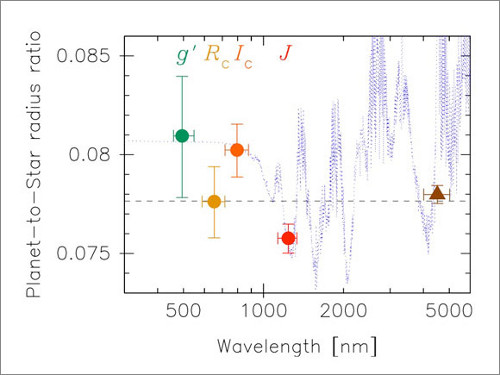
Image: Radius of each color measured (observation wavelength) of GJ3470b (shown as Planet-to-Star radius ratio). Credit:NAOJ.
From the paper:
A plausible explanation for the differences is that the planetary atmospheric opacity varies with wavelength due to absorption and/or scattering by atmospheric molecules. Although the significance of the observed Rp / Rs [the planet-to-star radius ratio] variations is low, if confirmed, this fact would suggest that GJ3470b does not have a thick cloud layer in the atmosphere. This property would offer a wealth of opportunity for future transmission-spectroscopic observations of this planet to search for certain molecular features, such as H2O, CH4, and CO, without being prevented by clouds.
In other words, the lack of a substantial cloud cover should make it easier to find traces of water or methane in the atmosphere that could give us clues as to how the planet formed — thick clouds would have masked the differences in radii by color that the researchers detected. The team hopes to conduct further observations of the planet using the 8.2-meter optical-infrared Subaru telescope on Mauna Kea in Hawaii, looking for further ways to characterize the world’s atmosphere and get a clue as to whether it formed in its present position or further out in the system, later migrating inward.
The paper is Fukui et al., “Optical-to-Near-Infrared Simultaneous Observations for the Hot Uranus GJ3470b: A Hint of a Cloud-Free Atmosphere,” in The Astrophysical Journal, Vol. 770 (2013), p. 95 ff. (abstract).

Testing Out Pulsar Navigation
Tracking spacecraft from Earth is an increasingly cumbersome issue as we continue to add new vehicles into the mix. The Deep Space Network can track a Voyager at the edge of the Solar System, but using round-trip times and the Doppler shift of the signal is a less than optimal solution for accurate tracking. What we’d like is a method that would allow the spacecraft to calculate its position on its own, taking precise readings from some system of celestial markers.
Pulsars have been in the mix in this thinking for some time. After all, these remnants of stars rotate at high speed and put out radiation beams that blink on and off at regular intervals. They’ve been called ‘celestial lighthouses’ because of this effect, and they’re usefully consistent, producing their pulses in intervals that vary from milliseconds to seconds. The easiest analogy is with the global positioning system, and in this recent article in IEEE Spectrum (thanks to Frank Smith for the pointer), that’s exactly how their use is described:
A craft heading into space would carry a detector that, similarly to a GPS receiver, would accept X-rays from multiple pulsars and use them to resolve its location. These detectors—called XNAV receivers—would sense X-ray photons in the pulsars’ sweeping light. For each of four or more pulsars, the receiver would collect multiple X-ray photons and build a “light curve.” The peak in each light curve would be tagged with a precise time. The timing of these peaks with respect to one another would change as you traveled through the solar system, drawing nearer to the source of some and farther from others. From this pattern of peaks, the spacecraft could calculate its position.
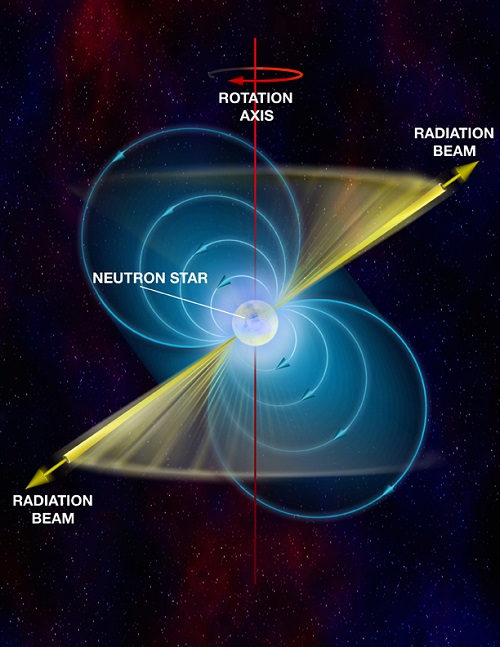
Image: The magnetic poles on a neutron star act like fountains, an escape valve for charged particles that get trapped in the star’s enormously strong magnetic field. As a neutron star spins, its polar fountains turn with it, like an interstellar lighthouse beam. From Earth, we see the beam as it quickly sweeps past us — there, gone, there, gone — many times a second. That looks like a pulse from here. Hence the name, “pulsar.” Credit: National Radio Astronomy Observatory.
Pushing the pulsar navigation idea forward is a table-top device known at NASA Goddard as the Goddard X-ray Navigation Laboratory Testbed (GXNLT), which has been developed to test out a navigation experiment that will be flown on the International Space Station as early as 2017. The ‘pulsar-on-a-table’ can mimic pulsar spin rates and model pulsar locations in the sky, simulating the environment that the upcoming ISS experiment will encounter. The X-ray photons it produces are detected and their arrival times processed by algorithms to extract orbital position.
These technologies are being validated for the Neutron-star Interior Composition Explorer/Station Explorer for X-ray Timing and Navigation Technology mission (NICER/SEXTANT), which will, in addition to demonstrating navigation by pulsars, study the interior composition of neutron stars (for more on NICER/SEXTANT, see this GSFC news release). The assumption is that like the 26-satellite GPS system, pulsar navigation will be able to use onboard software to calculate a position, but without the obvious, Earth-centric limitations of GPS signals.
Luke Winternitz, a co-developer of the Goddard testbed, thinks navigating with X-rays can open up deep space for autonomous navigation, and the test equipment is a vital step in shaking out the system:
“X-ray navigation has the potential to become an enabling technology for very deep space exploration and an important augmentation to NASA’s Deep Space Network. We had to have a way to test the technology. We have GPS constellation simulators that make our GPS receivers think they are in orbit; we needed something analogous for an XNAV receiver.”
So far the ground tests using the pulsar-on-a-table show that the system will be accurate within one kilometer in low-Earth orbit, but the goal is to reach accuracies in the hundreds of meters even in deep space. By the time we do get NICER/SEXTANT into place on the International Space Station, we should have a high degree of confidence that the system will work. Ultimately, basing navigation within the Solar System and beyond on Earth-based equipment will give way to autonomous navigation, a necessity for accuracy as well as practicality as we push outward.

Public Engagement in Deep Space
Congratulations to Icarus Interstellar, which with five days to go has easily surpassed its goal of raising $10,000 on Kickstarter. The campaign supports the Starship Congress to be held in Dallas August 15-18 at the Anatole Hilton Conference Center. It is described on the Kickstarter page as “…a forum where scientists, physicists, engineers, researchers, urban designers, representatives from international space programs and present-day commercial space operators, as well as popular and well-known interstellar speakers and space journalists share their visions for how the future of spaceflight and interstellar exploration is to unfold.”
The Kickstarter description also includes a quick refresher on Project Icarus itself, the main goals of which are:
- To design a credible interstellar probe that is a concept design for a potential mission this century;
- To allow a direct technology comparison with Daedalus and provide an assesment of the maturity of fusion-based space propulsion for future precursor missions;
- To generate greater interest in the real term prospects for interstellar precursor missions;
- To motivate a new generation of scientists to be interested in designing space missions that go beyond our solar system. [our emphasis]
Crowdsourcing a Space Telescope
And while we’re on the subject of Kickstarter, which raises public money through donations small and large, I’m seeing 19 days to go on the ARKYD space telescope project from Planetary Resources. Kickstarter works by letting you run a campaign with a definite time limit — the project is funded only if the goal is reached within the deadline. Planetary Resources already has $851,000 pledged toward a goal of $1 million in the service of a publicly accessible space telescope. It’s clear the funding mission will succeed, as have 43,000 other projects since Kickstarter’s 2009 launch, involving 4.2 million people in over $650 million in donations.
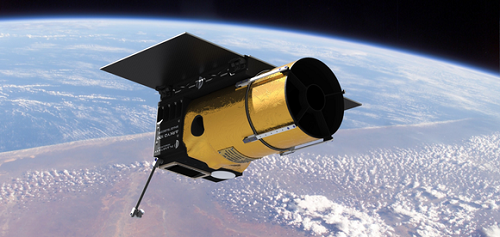
Image: The ARKYD 100 is the first private space telescope and a stepping-stone to near-Earth asteroids. This space telescope, utilized in low Earth orbit, represents the next milestone on our technology development roadmap. Credit: Planetary Resources.
With a 2015 launch in prospect, the ARKYD 100 makes Planetary Resources’ hunt for asteroids a reality to the public, some of whom, for a pledge of $99, will be able to use it to look at the object of their choice. A wide variety of rewards are available for pledges at many levels, including the prospect of having an asteroid named after the benefactor. But the real kick is to put public contributions large and small together to get a working scientific instrument into space. A $25 pledge nets you an image of yourself displayed on an ARKYD viewscreen as it orbits the Earth.
With a Web and mobile app on the way to handle photo uploading and retrieval as well as mission tracking, Planetary Resources has done a superb job of anticipating what it will take to energize students and build careers. But I like especially the philosophical aspect behind the project. The ARKYD 100 shows us that all of us can become a part of an ongoing effort to develop space resources, with contributions from all over the planet. I can see why there’s a rush to get this project funded as phase 1 of the larger goal of asteroid mining.
Currency and Deep Time
I can’t leave the subject of fundraising for worthy science without mentioning The Long Now Foundation’s ongoing effort to raise $495,000 in support of its Salon building project. Long Now is transforming its existing museum at Fort Mason Center in San Francisco into a showcase for the long-term projects it supports. Already the home of receptions and other small events, as well as a steady stream of students, tourists and other visitors, the museum now needs renovation to create a gathering space that incorporates Long Now artifacts, a two-story crowd-curated library, and an updated A/V system to support its public outreach.
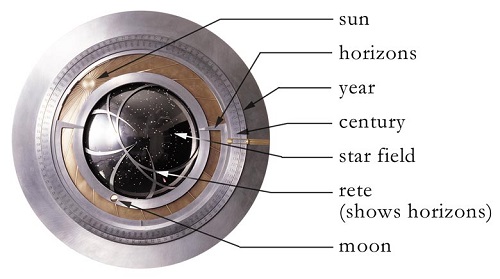
Image: The dial of prototype 1 of the 10,000 Year Clock, a vital part of the effort to expand human thinking to time-frames well beyond a single lifetime. Credit: Long Now Foundation.
The donation rewards here, like those for ARKYD, range across the price spectrum and include everything from exotic teas to flasks with the Long Now logo and a variety of unique spirits. What projects like these illustrate, though, isn’t easily captured in a material reward. For much of the public and for too long a time, science and exploration have become matters done by others, things to read about or watch on the news. Crowdsourcing is one way to get the public involved not through an obligatory tax but a voluntary contribution chosen out of personal interest in the subject.
We have many signs all around us that dedicated individuals can do things and make a difference in science. Maybe the most obvious example is the ongoing work of amateur astronomers who, with off-the-shelf equipment, are making a serious contribution to the exoplanet hunt not only through their own observations but also by working with images and light-curves made available on the Internet for close scrutiny by volunteers. Now through crowdsourcing, young people with a few dollars and genuine enthusiasm can feel themselves to be a part of this wave of public engagement. Exciting projects like these are well worth their attention.


